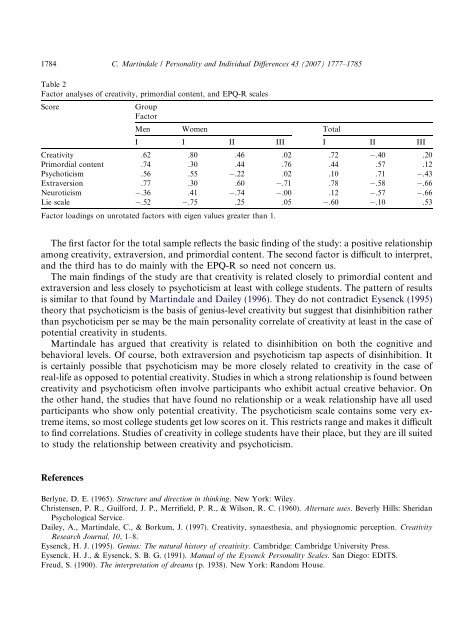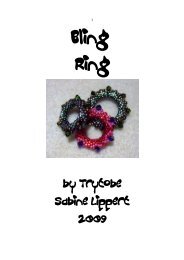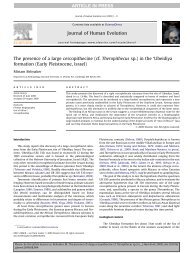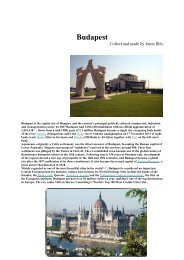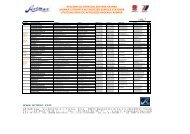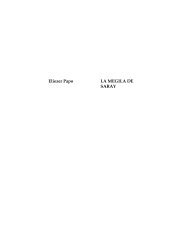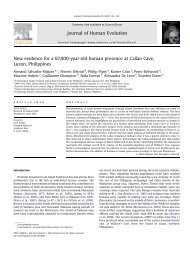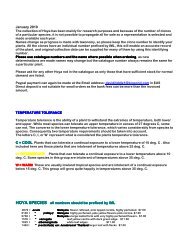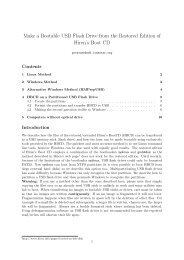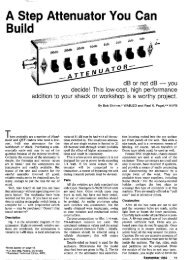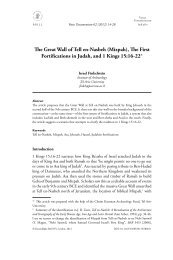Creativity, primordial cognition, and personality
Creativity, primordial cognition, and personality
Creativity, primordial cognition, and personality
Create successful ePaper yourself
Turn your PDF publications into a flip-book with our unique Google optimized e-Paper software.
1784 C. Martindale / Personality <strong>and</strong> Individual Differences 43 (2007) 1777–1785<br />
Table 2<br />
Factor analyses of creativity, <strong>primordial</strong> content, <strong>and</strong> EPQ-R scales<br />
Score Group<br />
Factor<br />
Men Women Total<br />
I I II III I II III<br />
<strong>Creativity</strong> .62 .80 .46 .02 .72 .40 .20<br />
Primordial content .74 .30 .44 .76 .44 .57 .12<br />
Psychoticism .56 .55 .22 .02 .10 .71 .43<br />
Extraversion .77 .30 .60 .71 .78 .58 .66<br />
Neuroticism .36 .41 .74 .00 .12 .57 .66<br />
Lie scale .52 .75 .25 .05 .60 .10 .53<br />
Factor loadings on unrotated factors with eigen values greater than 1.<br />
The first factor for the total sample reflects the basic finding of the study: a positive relationship<br />
among creativity, extraversion, <strong>and</strong> <strong>primordial</strong> content. The second factor is difficult to interpret,<br />
<strong>and</strong> the third has to do mainly with the EPQ-R so need not concern us.<br />
The main findings of the study are that creativity is related closely to <strong>primordial</strong> content <strong>and</strong><br />
extraversion <strong>and</strong> less closely to psychoticism at least with college students. The pattern of results<br />
is similar to that found by Martindale <strong>and</strong> Dailey (1996). They do not contradict Eysenck (1995)<br />
theory that psychoticism is the basis of genius-level creativity but suggest that disinhibition rather<br />
than psychoticism per se may be the main <strong>personality</strong> correlate of creativity at least in the case of<br />
potential creativity in students.<br />
Martindale has argued that creativity is related to disinhibition on both the cognitive <strong>and</strong><br />
behavioral levels. Of course, both extraversion <strong>and</strong> psychoticism tap aspects of disinhibition. It<br />
is certainly possible that psychoticism may be more closely related to creativity in the case of<br />
real-life as opposed to potential creativity. Studies in which a strong relationship is found between<br />
creativity <strong>and</strong> psychoticism often involve participants who exhibit actual creative behavior. On<br />
the other h<strong>and</strong>, the studies that have found no relationship or a weak relationship have all used<br />
participants who show only potential creativity. The psychoticism scale contains some very extreme<br />
items, so most college students get low scores on it. This restricts range <strong>and</strong> makes it difficult<br />
to find correlations. Studies of creativity in college students have their place, but they are ill suited<br />
to study the relationship between creativity <strong>and</strong> psychoticism.<br />
References<br />
Berlyne, D. E. (1965). Structure <strong>and</strong> direction in thinking. New York: Wiley.<br />
Christensen, P. R., Guilford, J. P., Merrifield, P. R., & Wilson, R. C. (1960). Alternate uses. Beverly Hills: Sheridan<br />
Psychological Service.<br />
Dailey, A., Martindale, C., & Borkum, J. (1997). <strong>Creativity</strong>, synaesthesia, <strong>and</strong> physiognomic perception. <strong>Creativity</strong><br />
Research Journal, 10, 1–8.<br />
Eysenck, H. J. (1995). Genius: The natural history of creativity. Cambridge: Cambridge University Press.<br />
Eysenck, H. J., & Eysenck, S. B. G. (1991). Manual of the Eysenck Personality Scales. San Diego: EDITS.<br />
Freud, S. (1900). The interpretation of dreams (p. 1938). New York: R<strong>and</strong>om House.


